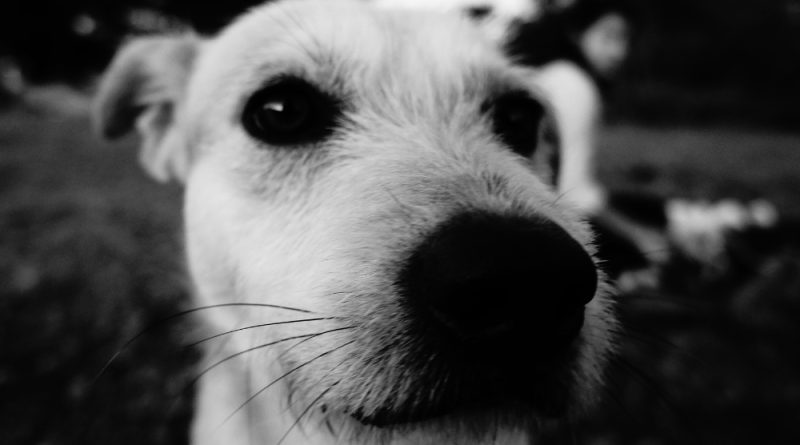Can you cut the dog’s whiskers?
Can you cut a dog’s whiskers, or are those little hairs that grow on their face important? This doubt is very common, especially for first-time dog owners.
The truth is that a dog’s whiskers are a crucial item for the survival and development of your best friend. Your dog really needs those little whiskers that grow on their face.
But don’t worry. In this article from Portal do Dog, you will understand everything about a dog’s whiskers. Find out if you can cut a dog’s whiskers, how to preserve them, and other tips.
But can you actually cut a dog’s whiskers?
No, you cannot cut a dog’s whiskers. By cutting a dog’s whiskers, you will be eliminating a series of stimuli and sensations for your dog.
After all, a dog’s whiskers are essential for the dog to understand its surroundings, the environment, and many other factors. Whiskers act as locator antennas providing information for your dog’s safety.
Therefore, cutting a dog’s whiskers is truly detrimental from a well-being perspective. Dogs need their whiskers to feel comfortable and understand their surroundings.
However, some owners still choose to trim these whiskers to make the animal look “prettier,” especially for contests or similar events.
Nevertheless, trimming the whiskers should not happen, at least not at home and without professional supervision. The dog’s whiskers, also known as vibrissae, have crucial nerve endings. The whiskers provide a lot of information to the dog.
To learn more about vibrissae or a dog’s whiskers, keep reading.
So, what is the purpose of a dog’s whiskers?
A dog’s whiskers are not just long hairs that grow on the animal’s face. They are also crucial nerve endings for various situations.
In other words, a dog’s whiskers serve to locate the animal in its environment and to protect it. Instinctively, a dog needs its whiskers for survival.
Therefore, you should never cut a dog’s whiskers for any reason other than a veterinary recommendation.
Only a veterinarian can perform a cut if it is genuinely necessary for some reason.
Here are some functions of a dog’s whiskers:
- Understanding the environment.
- Sensing air currents and feeling the temperature.
- Determining whether the space is large or small.
- Assisting with a dog’s blind spots.
Understanding the environment
First and foremost, it is essential to understand that your dog’s whiskers are not just long hairs. They are also focal points for information.
With long hairs on their face (whiskers), dogs can comprehend their surroundings. They can perceive things and sense “what is coming.”
With their whiskers, dogs can perceptively feel the environment. They know when someone is nearby or if something is happening where they cannot see, etc.
Sensing air currents and feeling the temperature
Another benefit of canine whiskers for dogs is their ability to sense temperature using these long hairs. They can tell if it is too cold or too hot based on the nerve endings of the whiskers.
Vibrissae, as a dog’s whiskers are called, have this name because they vibrate. That is, they move when there is a change in the environment.
These vibrations send crucial information to the dog’s brain. Likewise, when it comes to the temperature of the environment, the same process occurs.
The whiskers sense the temperature and relay that information to the dog’s brain.
Determining whether the space is large or small
Dogs are more carefree than cats, especially when it comes to being cautious while moving from one place to another. However, they are still cautious for a reason: their whiskers!
The whiskers of a dog help it understand the configuration of the space. They know, through their whiskers, whether the space is large or small, wide or narrow.
This information is processed by the dog’s brain and reflected in the animal’s physical actions. This is how dogs know if they can enter certain environments or places.
Assisting with a dog’s blind spots
If you have silently placed a dog treat under your dog’s nose, and the dog has not made any movement to grab it, there is a reason for that. The reason is the blind spot.
Of course, if the dog smells the treat or sees you placing it there, it will grab it. But if you do it discreetly, the dog will not notice.
It will only notice if the whiskers vibrate, if the vibrissae send a nerve signal to the brain. Then, the dog will look at the blind spot and find the treat.
Yes, a dog’s whiskers are crucial for them!
When do a dog’s vibrissae appear?
Vibrissae, or canine whiskers, appear on a dog’s body almost instantly. That is, when puppies are born, they already have their first vibrissae.
This is different from what happens with the human body, where facial hair only appears after many years during puberty. However, in dogs, it is almost instantaneous.
This shows how crucial vibrissae are for dogs, doesn’t it?
In conclusion, never cut your dog’s whiskers for any reason. If there is no explicit recommendation from the veterinarian (and the veterinarian performs the cut), never perform this procedure.
A dog’s whiskers are crucial for the survival of your dog. They need vibrissae to locate themselves, recognize spaces, and other important things.
Next, see all the types of canine whiskers that can appear on your dog:
- Labial: hairs around the lips;
- Supraciliary: the dog’s eyebrows;
- Interramal: like the dog’s beard, located on the chin;
- Mandibular: hairs on the dog’s jaw;
- Zygomatic: hairs on the cheeks.
Dog breeds with whiskers – What are the main ones?
Now that you know you cannot cut your dog’s whiskers, see a list of dog breeds that have a lot of little whiskers on their faces:
- Border Collie;
- Fox Terrier;
- Maltese;
- Yorkshire Terrier;
- Lhasa Apso;
- Schnauzer;
- Pekingese;
- Shih Tzu.
This does not mean that other dog breeds do not have whiskers. On the contrary, all of them have whiskers due to the biological factors mentioned in this article.
In other words, without whiskers, there is no perception of the environment and important sensations for the dog’s survival.
Why you should never cut a dog’s whiskers
A dog’s whiskers are not there for no reason. They are there for an important, fundamental, and decisive reason for the dog’s survival and well-being.
Some owners, when trimming their dog’s fur, end up cutting the facial hairs. However, this is very harmful to the dog’s development and daily life.
By cutting the facial hairs (whiskers), dogs lose a rich source of information for the brain.
Unless the cut is a veterinary recommendation for health reasons, let the whiskers grow!
Here are some reasons not to cut a dog’s whiskers:
It loses spatial awareness.
It loses awareness of the weather.
It no longer recognizes environments.
He loses the ability to perceive surroundings.
He loses spatial awareness
Having spatial awareness is essential for dogs.
After all, they need to know where they are stepping, where they are going, and what lies ahead. Especially larger dogs that can bump into things.
Therefore
, if you simply cut your dog’s whiskers, it may lose this spatial awareness. As a result, it may start bumping into things and even hurting itself.
Growing puppies need their whiskers a lot. Many times, they are not aware that they have grown and continue trying to access small spaces that no longer fit.
The whiskers, in this case, help create that perception.
It loses awareness of the weather
Perceiving the weather is another crucial factor for dogs to feel comfortable. Of course, they will continue to feel hot or cold regardless of their whiskers.
However, whiskers act as a thermometer for them to react and understand if it is too hot or too cold.
The signals sent to the brain help the dog make the right decisions to avoid getting too tired or feeling unnecessary cold.
It no longer recognizes environments
A dog’s whiskers help the dog “memorize” spaces. That is, they already know where they can step, where it is safe, what is behind a wall, and things like that.
The vibrations that the whiskers provide to send information are crucial for the survival and well-being of your dog.
Therefore, never cut your dog’s whiskers!




